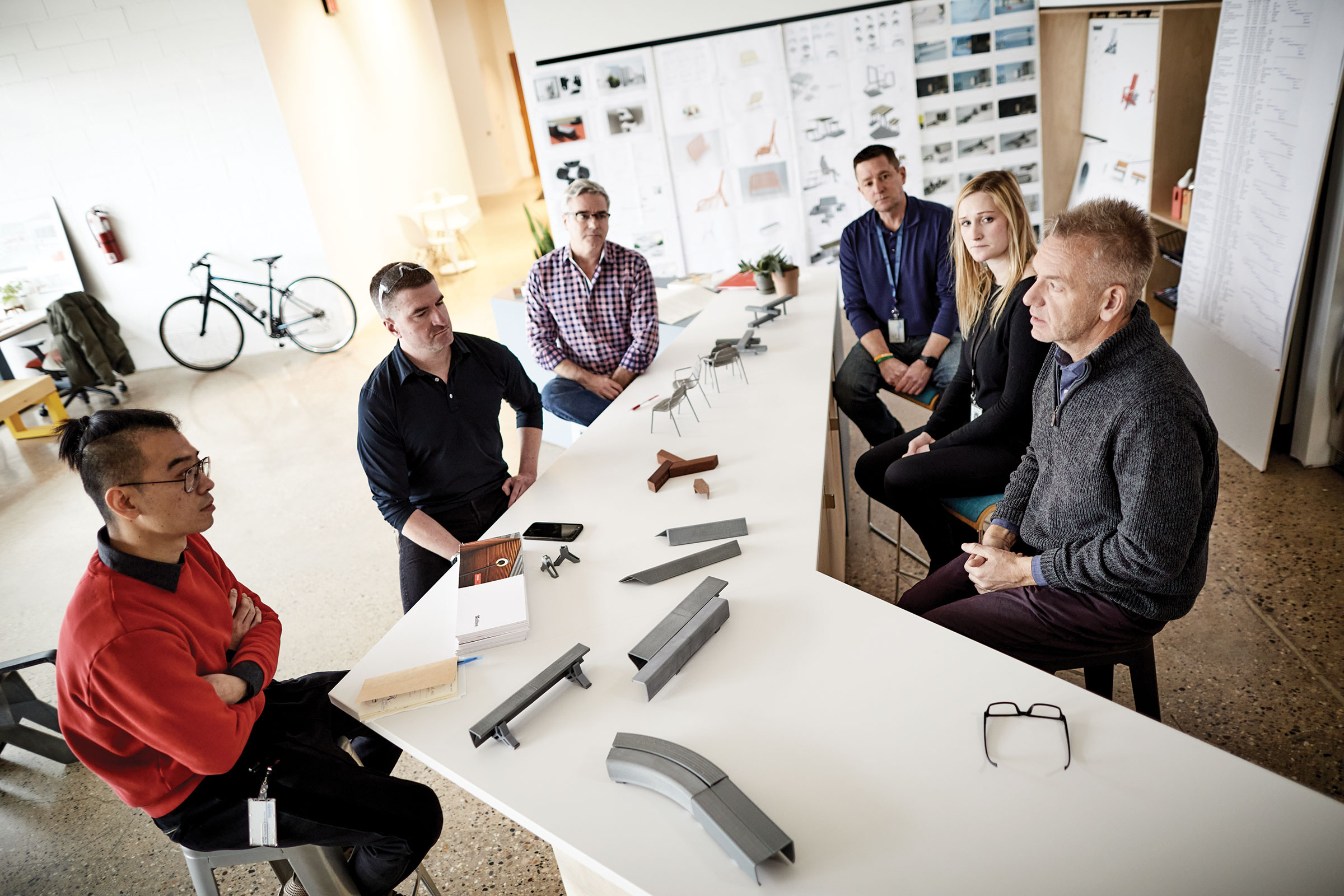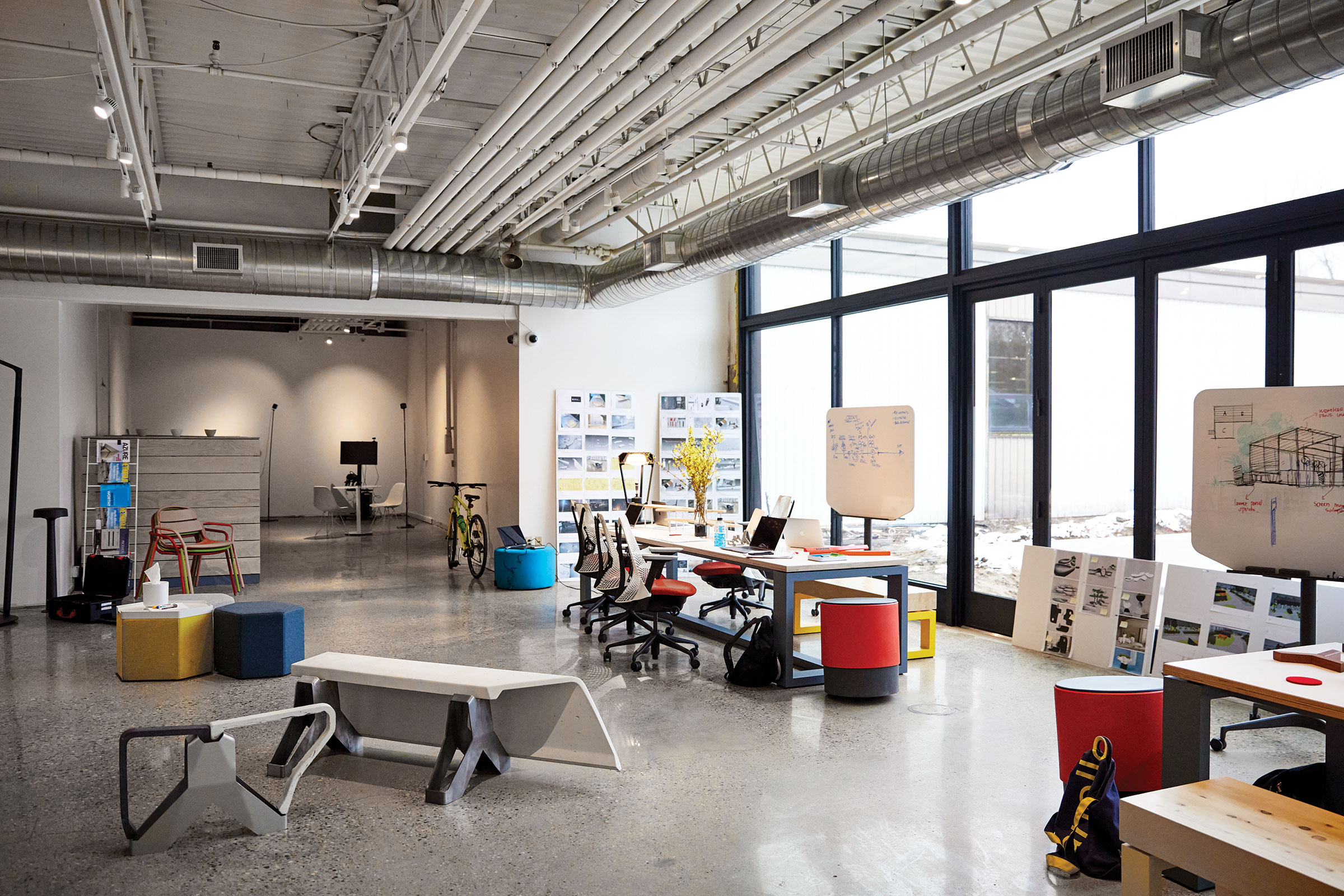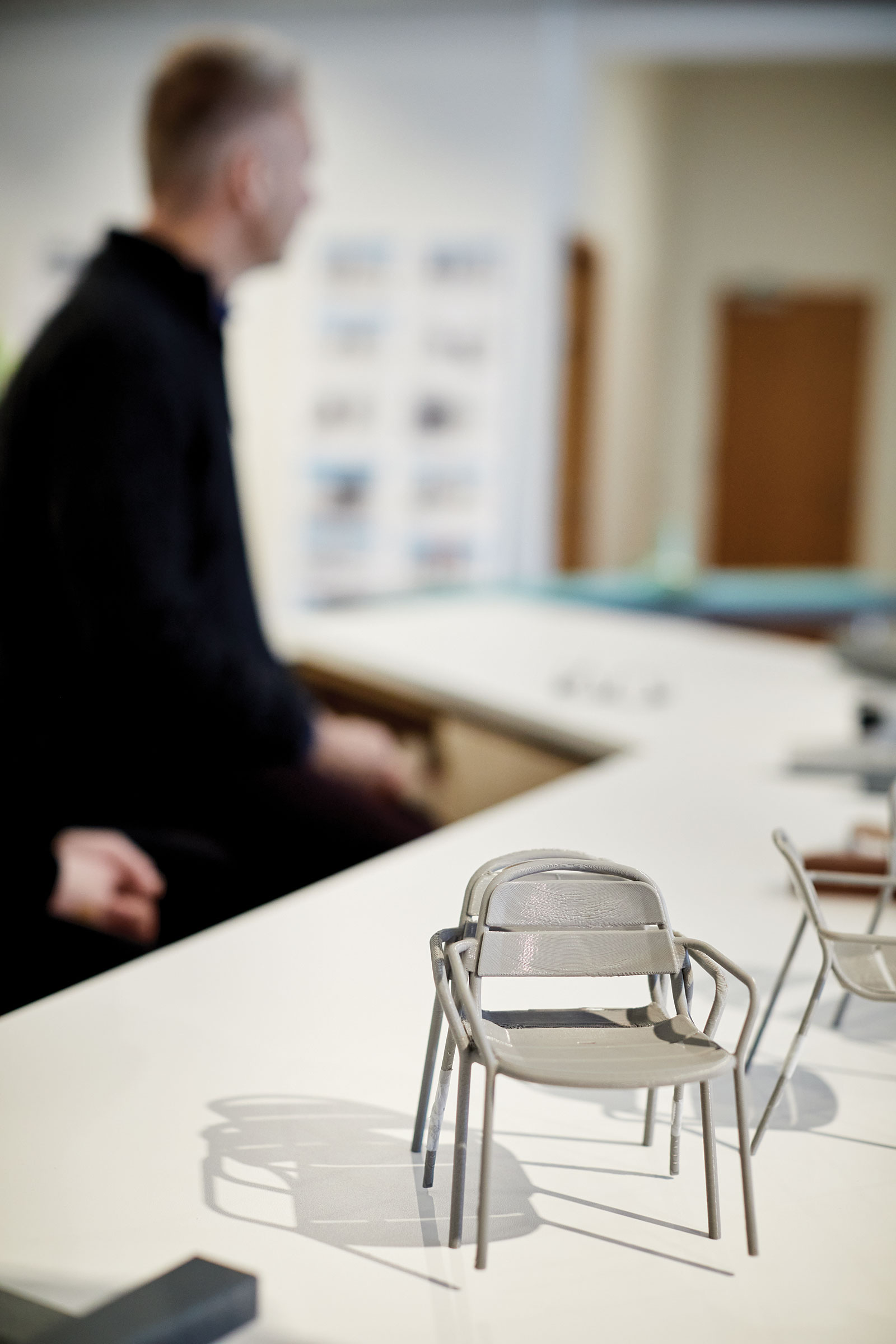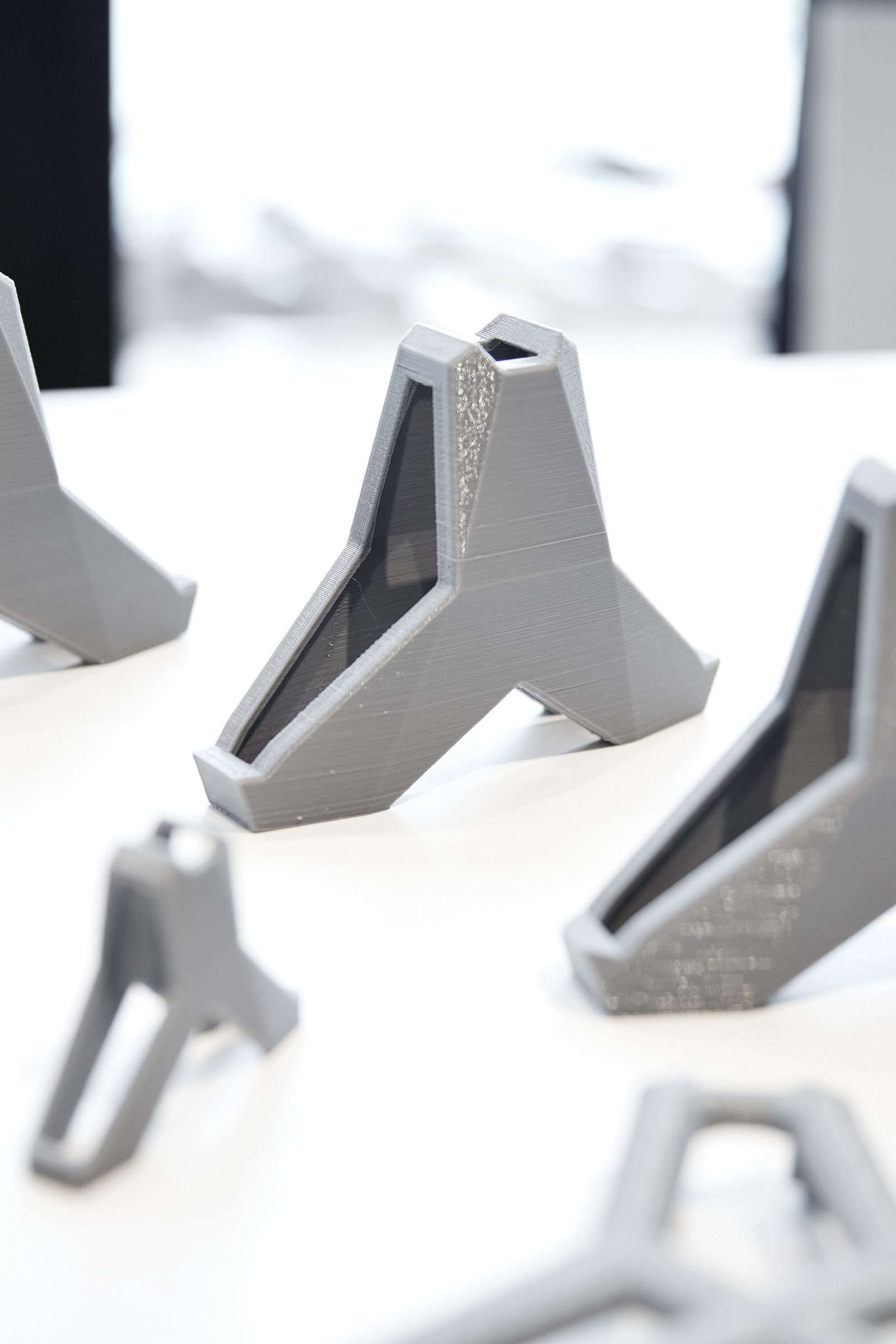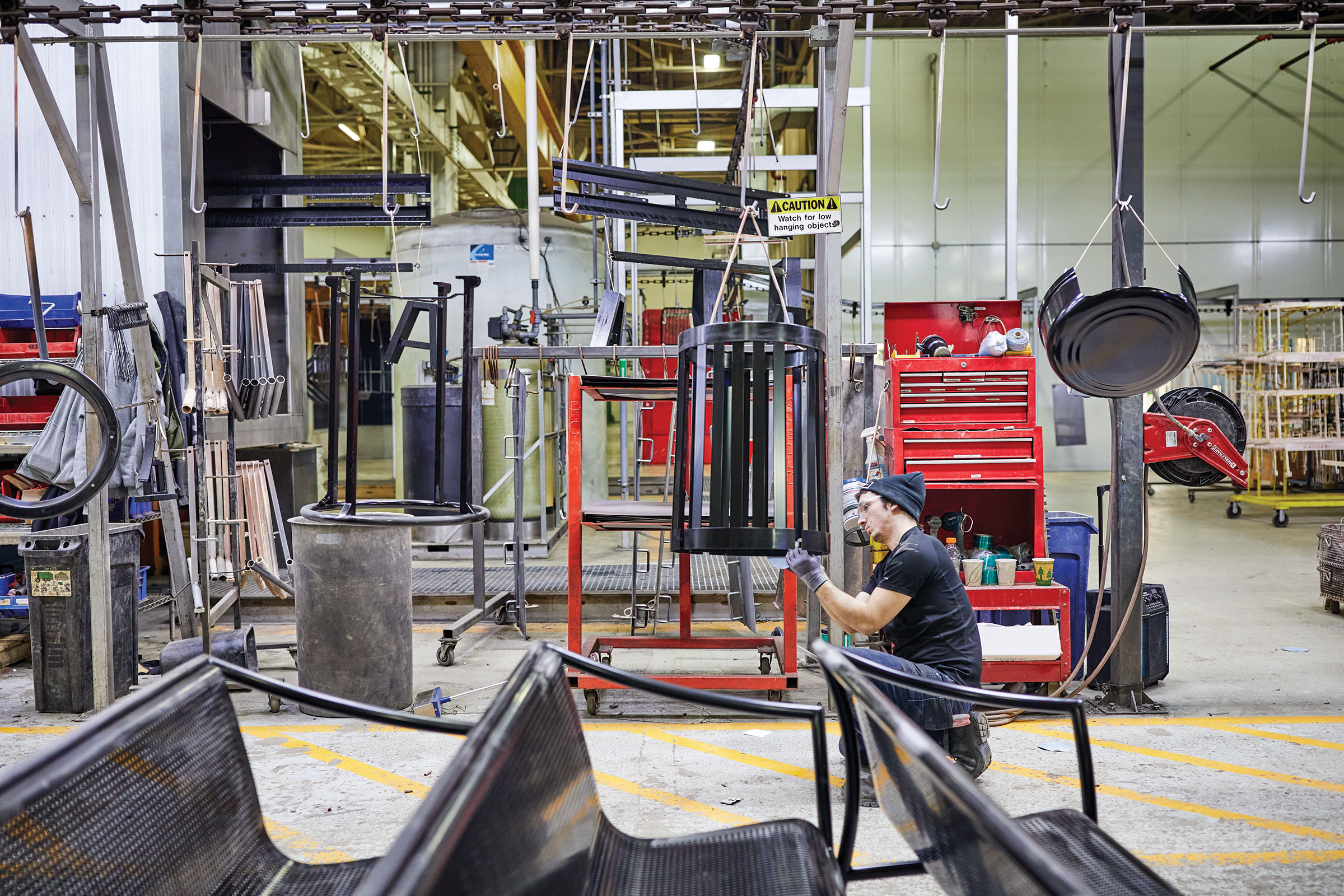Kirt Martin really wants me to meet everyone. When I arrive at Landscape Forms—a sprawling three-facility campus in Kalamazoo, Michigan with more than 430 full-time employees currently—the chief creative officer is eager to show me around. I shake hands with two dozen people, all of them eager to tell me how they fit into the award-winning design story that is the outdoor site furnishings and lighting company.
“This is our design space,” Kirt says as we push through the doors of the design center. Inside, printouts are tacked up to display projects in progress—like an outdoor modular seating and lighting system that’s in progress with Designworks, the BMW Group subsidiary that works for a variety of industries. In the middle of the room, tiny 3D printed chairs and benches from that project remind everyone of today’s to-do list, and a nearby long list of deadlines is printed so large you can see it nearly anywhere you stand. “We try to keep all of our work visual because we want to make sure people are weighing into the concepts,” Kirt says as he walks me through how the design process here really works.
Currently Landscape Forms works with more than 20 outside design partners, a lot for a firm of this size. At a long, low table in front of the design center’s windows, 20-something industrial designer Site Li sits at his laptop, going back and forth with designers all over the world. In addition to Designworks, Site’s also working on a project with Claudia Issa from Brazil; early concept renderings of their collaboration fill the room. “Claudia is more like an artist than a designer,” Site says. “We work with people from diverse backgrounds so we can keep learning and expanding our product and get inspiration from different industries.”
- Pieces of the serpentine, mix-and-match style benching that will soon become part of the Designworks project are made into large cast concrete prototypes and sit in the design center, awaiting feedback. Photo by Pete McDaniel
Kirt calls Site, a recent Cranbrook Academy graduate with five years in the industry, one of the team’s “translators,” as he liaises between partners and Landscape Forms. “The beauty of working with outside designers is we can cross-pollinate from other industries,” Kirt says. “Here we are, this little company in Kalamazoo (population 75,000), and we can compete globally because we’re pulling in designers and great thinking from around the world.” Designworks is just one example of international collaboration. The most recent project is set to launch in late 2020, offering up a serpentine variety of benching with integrated lighting, all made of concrete.
At Landscape Forms, the design, engineering, and marketing teams work together from day one. Kirt says that’s unusual for most organizations, as processes typically start with design before they’re unveiled to engineering. James Bucholtz, product engineering group leader, says that structure helps the process move quickly and keeps everyone on the same page. It also means getting to work across departments, which James loves. “I work with the design team upfront. I work with the marketing team toward the end during product launches and photo shoots. In the middle I’m working with supply chain, manufacturing, the tool room, just about everybody who touches this product. Everybody along the way has an opportunity to look at new products coming down the line to make sure we’re making it a manufacturable, repeatable product.” Strong collaboration has led to some 70 design awards in less than 10 years, including the most recent 2020 Red Dot Award for Product Design.
Not everyone always agrees throughout the back and forth process, though. Kirt calls it creative abrasion. “We have to hug it out,” he laughs. “That’s built in. We want to be people who disagree during the day but don’t stop being friends at night.”
- The design center is home to many mockups, 3D printed pieces, and concrete prototypes to represent ongoing Landscape Forms projects. Photo by Pete McDaniel
- The team 3D prints elements of the overall design concept. Photo by Pete McDaniel
Frequent five-minute discussions, or sometimes debates, happen each day as projects progress. “Designers will tell you they dream in the clouds—they have all these pretty things they see in their minds,” James says. “But even when we have to actually build it, there’s never any pushback that’s like, ‘We can’t do that.’ We always want to figure out together the best way to achieve the design intent.”
It’s part of the company’s overall ethos, as this group really does seem to share everything from lunch to profits. Landscape Forms launches anywhere from eight to 16 new outdoor products (site furnishings, lighting, structures, and more) each year—hence the ever-present list of deadlines on display. It’s a lot more than other companies launch annually, Kirt says. “Our pathway to growth has traditionally been through new product development. We don’t let up on new products,” Kirt says, adding that some companies in the region take years to develop a single product. He simply can’t imagine it. “I can’t see that ever being our reality.”
The design process starts when there’s a new program. About a half-dozen team members make up Landscape Forms’ strategy team, which vets new program ideas that can really come from anywhere. “If you work in the plant or in the office or in sales, if you have an idea for a project, you can write a program,” Kirt says. “We just had a guy in our tool room write a program and we approved it. We approved a project from a new employee who’s six months out of college who has potential. It’s cultural, too, to think if you see a problem to solve you can solve it.”
Last year Landscape Forms launched 12 new products. Getting things into design and prototyping quickly allows the team to learn fast and for less cost. That’s partly why they keep all of the mockups, models, and drawings out in the open. “We want everyone to challenge our thinking. When we mock it up, be that a 3D printed or a handheld model, it’s about soliciting feedback,” he says. “The goal here isn’t to do what Site wants or Kirt wants; it’s to do the right thing for the organization.”
- Designworks project in the prototype stage. Photo by Pete McDaniel
Staying on track is important, as 25% of Landscape Forms’ overall sales come from products that are five years old or newer. One of Landscape Forms’ newest and award-winning products is Upfit, an adaptive structure that takes work outside with solar technology built in so you can stay charged. “There’s huge value in creating outdoor amenities that provide value like outdoor power and technology support,” Kirt says. “It creates better spaces for people to interact and work outdoors.” Ninety percent of Landscape Forms’ customers are landscape architects (the company was founded more than 50 years ago by a landscape architect), and they’re also known for their custom high-end branded environments, like the benches and planters in Times Square.
After a quick coffee break, I climb in the Landscape Forms van with Senior Designer Brian Revoir and a few others for a tour of the 265,000-square-foot Midlink facility just a few miles away. The factory itself gives off a Willy Wonka vibe—if you substituted chocolates for upside down benches floating on overhead conveyor belts. I put on a pair of safety goggles and am reminded to watch where I’m walking—stay within the yellow lines—as forklifts zoom by. Landscape Forms took over part of this space, a former GM manufacturing warehouse, five years ago when they needed room to grow their manufacturing needs.
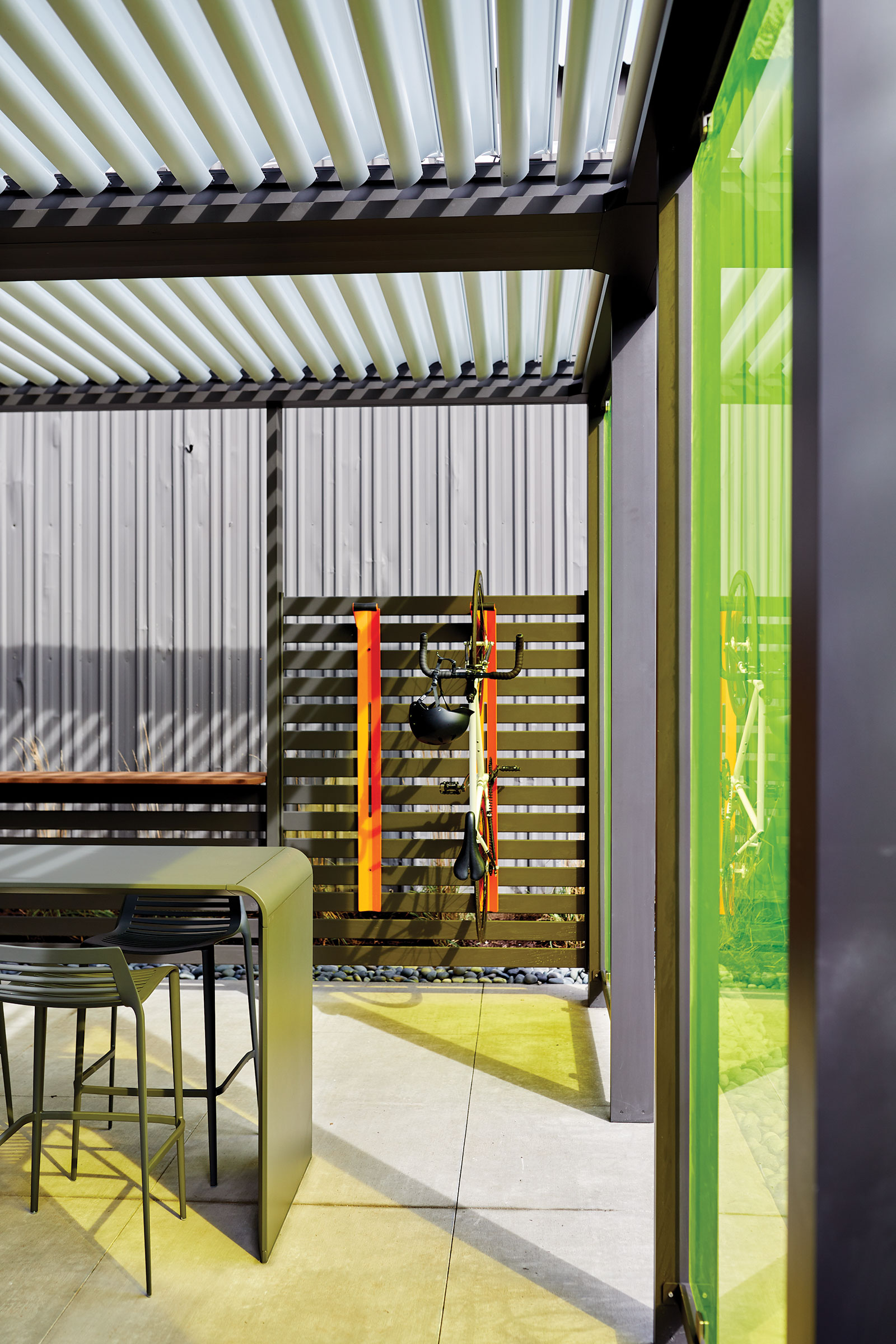
One new Landscape Forms product is Upfit, an adaptive outdoor structure with solar charging technology. “It creates better spaces for people to interact and work outdoors,” says Kirt Martin, chief creative officer at Landscape Forms. Photo courtesy of Landscape Forms
Before long we’re back at the East Michigan Avenue headquarters, venturing deep into the belly of the loud and dusty warehouse space, where prototypes for the Designworks project are under review. The team is checking out the latest mold to see how it’s holding up. What started as three pieces of orange foam was cut and stacked, then sculpted and filled with silicone and Bondo, sanded, primed, and waxed. “We didn’t even know if we could do this at first,” Brian says. “We’re doing these thin concrete molds and setting them on really cool structural legs. This way the customer’s not paying for solid pieces of concrete, we’re shipping less weight, and we can stack them into each other. The configurations are also really cool, and the technology and lighting will run through it.”
Meanwhile, across the Atlantic Ocean in a redbrick building surrounded by startups in Munich, a handful of designers pore over drawings and images of the prototype. They’re more than 4,000 miles away from Site and his laptop, but they and Tobias Adami, creative director at the European studio of Designworks, meet with him virtually on a regular basis.
Tobias says the process always starts with a conversation—what are we trying to accomplish and what do we have in mind? “We support this with really fast, easy sketches. We’re in a digital world, but we use these analog work methods because if you can see something sketched on a piece of paper it leaves things open—there’s a lot of space for interpretation,” he says. “This leads to new ideas.”
Technical drawings confirm when everyone agrees on proportions and final dimensions. “This helps us understand, for example, how people will use the seating,” Tobias says of the current collaboration. “We’ve designed this so people who want to rest for a short time can sit on that furniture in a normal position, but we’ve also allowed for larger seating surfaces that invite people to lay back and lounge.”
Technical drawing and 3D modeling in Munich combined with models and prototypes in Kalamazoo bring the project to life. “In the end we’re able to produce 1:1 prototypes or mockups so we can see how things really perform—checking the weight, overall appearance, and seeing how everything fits together,” Tobias says. “This helps our team at Designworks better evaluate how the final objects express themselves whether it’s daytime, nighttime, or under various other light conditions.”

“We endeavor to be socially, economically, and environmentally sustainable,” Kirt Martin, chief creative officer at Landscape Forms, says of everything Landscape Forms does. Photo by Pete McDaniel
Back in Kalamazoo, Brian looks over the latest prototype, which the team was able to make quickly so they could determine what worked. “Instead of making things out of foam or paper or wood to begin with, we dove right into making molds in concrete because we’ve never done benches of that length with that kind of a thin cross-section before,” he says.
Tobias says projects like these are the exciting collaborations both teams crave. Sometimes the designers and engineers even switch roles, with the designers talking about the production process or materials and the engineers doing sketches. “It’s really interesting and not quite normal. There’s a real handshake there,” he says. “If you’re really interested in doing something that’s better, that goes beyond, that helps people or offers new perspectives, you have to be open.”
This article originally appeared in the Spring/Summer 2020 issue of Sixtysix with the headline “Design Philosophy.” Subscribe today.
PRODUCTION CREDITS
Produced by Studio Sixtysix
Words by Laura Rote
Photos by Pete McDaniel
Studio Sixtysix is the in-house creative agency to Sixtysix magazine. Studio Sixtysix stories are conceived, produced, and edited by Studio Sixtysix.
